Railroad Workers Move Trains Safely and Efficiently
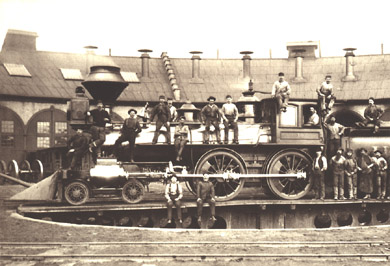 A study of the railroads is more that a study about brick, mortar, ribbons of steel and fast locomotives.
It is also a study about the many people who run a railroad, the train crews, station crews, telegraph operators, yard
masters, maintenance crews, watch inspectors, crew dispatchers, train dispatchers, management and others. All have
worked together to make trains run safely and efficiently since trains began rolling in North
America.
A study of the railroads is more that a study about brick, mortar, ribbons of steel and fast locomotives.
It is also a study about the many people who run a railroad, the train crews, station crews, telegraph operators, yard
masters, maintenance crews, watch inspectors, crew dispatchers, train dispatchers, management and others. All have
worked together to make trains run safely and efficiently since trains began rolling in North
America.
A visit to today's western railroad museums and heritage railroads isn't just about cars and locomotives either. Today volunteers and staff fill the positions and rolls of the railroads workers doing the same tasks with the vintage railway cars, locomotives, stations, signals, tools and track before them. Often retired railroad workers have assisted, shared their stories, and shown a younger generation, now volunteers and staff, how the job is done using the vintage railroad equipment and tools, so that they in-turn can pass the information along to future generations.
Evolving railroad technology has changed the way railroads operate, as inventors and the railroads have found ways to use new technologies. The introduction of airbrakes, knuckle couplers, larger steam locomotives, diesel locomotives, computers and fiber optics have changed the way railroad workers work and interact. On modern railroads many of the positions and roles are still similar to the positions of previous generations, embracing newer technology, yet taught by the experienced workers as each new generation of railroad workers has started working their way up the ladder.
Train Crew
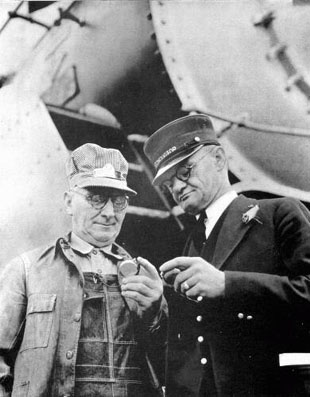 The Conductor has been the most familiar railroad worker to the average passenger since the 1840's. Wearing
his distinguishing uniform and hat, the Conductor has been the one that took the tickets, sold passage to those who boarded
the train without purchasing a ticket where there was no ticket agent, supervised the other trainmen, settled arguments,
and admonished misbehaving children or inebriated passengers. He has presided over the cars in the train with a fatherly
dignity, answered passengers questions about many things, and performed a "public relations" function for the railroad
company.
The Conductor has been the most familiar railroad worker to the average passenger since the 1840's. Wearing
his distinguishing uniform and hat, the Conductor has been the one that took the tickets, sold passage to those who boarded
the train without purchasing a ticket where there was no ticket agent, supervised the other trainmen, settled arguments,
and admonished misbehaving children or inebriated passengers. He has presided over the cars in the train with a fatherly
dignity, answered passengers questions about many things, and performed a "public relations" function for the railroad
company.
The Conductor is the railroad employee charged with the management of a freight or passenger train, and is also the direct supervisor of the train's "Train Crew". The conductor is required to cary an accurate watch, which is regularly inspected, and ensure that the train is running according to the timetable. The Conductor is responsible for signaling the engineer when to start moving and when and where to stop. On a freight train the Conductor is also responsible for keeping the record of the consignment notes and waybills, and directs switching the train needs to perform to drop off and pick up cars along the line.
The locomotive Engineer was the most heroic and glamorous figure during the nineteenth century, for he was the one that was capable of making the steam locomotive come to life and pull the train on its journey. If the locomotive needed to be repaired in a remote area, he was the one who fixed it. The nineteenth century locomotive Engineer enjoyed the privileges of the office. On many railroads the engineer was allowed customize the ways his engine painted. Many altered the sound of the whistle by placing wooden stops in it, to create a unique and distinct sound. To become an engineer he had to work his way up. Quite often he started out years before as a Wiper in a yard house, then worked his way up to Engine Watchman, then to Switch-engine Fireman, then Road Fireman, then Hostler, then to Engineer.
The Engineer is the person in charge of and responsible for the locomotive(s). An Engineer is responsible for preparing equipment for service, checking paperwork and the condition of the locomotives. He is also in charge of the mechanical operation of the train including controlling steam pressure, boiler water level, fire box temperature, acceleration, braking and handling of the train underway. He needs to know the physical characteristics of the railroad, including passenger stations, the incline and decline of the right-of-way and speed limits. As the train is moving he watches for obstructions on the rails ahead. Along with the conductor, the engineer monitors time so the train doesn't fall behind schedule, nor leave stations early. The train's speed must be reduced when following other trains, approaching route diversions, or when regulating time over road to avoid arriving too early.
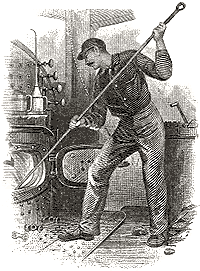 The Engineer and the Conductor,
who is in charge of the train, compare watches to ensure they are both set to railroad standard time,
review any train orders received, and share responsibility for the safe operation of the train and application of the rules
and procedures of the railway company.
The Engineer and the Conductor,
who is in charge of the train, compare watches to ensure they are both set to railroad standard time,
review any train orders received, and share responsibility for the safe operation of the train and application of the rules
and procedures of the railway company.
The Fireman on a steam locomotive feeds the firebox with fuel while the engine is in use. Steam locomotives typically ran on coal, wood or oil. Loading the fuel was typically hard work, wood and coal were transferred or shoveled from the tender to the firebox by hand. Early engines burned from 40 to 200 pounds of coal per mile, depending on the quality of the coal and on the Engineer. The Fireman also monitored the water level in the boiler. Another job of the Fireman was to keep the cylinders on the drive wheels oiled while the train was underway. Prior to 1888, this could only be done by climbing out on the running boards and creeping forward alongside the hot boilers to pour tallow on the valves. This duty ended when a device was invented that mixed oil with the water that was turning into steam. This allowed a self-lubrication to take place in the drive piston cylinder and all of the related valves.
A Fireman learning the trade typically started as a Switch-engine Fireman, who worked in yard. More experienced were the Road Fireman, who traveled with the freight or passenger trains. On diesel locomotives, the firemen would monitor controls and assist the engineer. Often Firemen served these duties as a form of apprenticeship, aspiring to be locomotive Engineers themselves. The Fireman new that if he did his job well, in about three years he would move up to Hostler, and then to Switch-engine Engineer before becoming a journeyman Engineer.
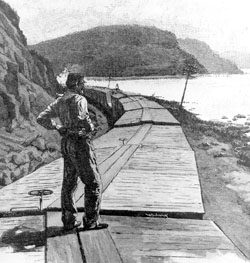 The Brakemen in
the early years would apply the brakes by turning the brake wheel on the top of each car when the engineer signaled to stop
the train. Two Brakemen would work from the front and rear of the train moving from car to car applying hand brakes on each
car until the train would come to a stop. At a siding, the Brakeman was also responsible for aligning the track switches when
needed, and was responsible for coupling and uncoupling cars to be left or picked up at a station or siding.
The Brakemen in
the early years would apply the brakes by turning the brake wheel on the top of each car when the engineer signaled to stop
the train. Two Brakemen would work from the front and rear of the train moving from car to car applying hand brakes on each
car until the train would come to a stop. At a siding, the Brakeman was also responsible for aligning the track switches when
needed, and was responsible for coupling and uncoupling cars to be left or picked up at a station or siding.
George Westinghouse patented the design for a fail-safe air brake system in 1872 which allowed the locomotive engineer to apply brakes for the entire train using compressed air. Under the Westinghouse system, brakes are applied by reducing train line pressure, and released by increasing train line pressure. When the engineer applies the brake by operating the locomotive brake valve, it reduces the train line pressure and in turn triggering the triple valve on each car to feed air into its brake cylinder. When the engineer releases the brake, the locomotive brake valve portal to atmosphere is closed, allowing the train line to be recharged by the compressor of the locomotive. The subsequent increase of train line pressure causes the triple valves on each car to discharge the contents of the brake cylinder to atmosphere, releasing the brakes and recharging the reservoirs.
With air brakes installed, brakes only required to be individually hand set when the cars were left standing in a yard or on a siding. After the introduction of air brakes only one brakeman was needed. The Safety Appliance Act in 1893 made air brakes and automatic couplers mandatory on all trains in the United States.
On some nineteenth century railroads the train crew also included a Flagman. When a train was required to stop for some unusual reason, and would be blocking the main set of tracks, the Flagman's job was to set flares and warning devices along the track in the direction of any expected train, then they were to station themselves at a visible point as far down the tracks as possible to be able to warn any oncoming train of the dangers ahead. On other railroads, and after the introduction of airbrakes, these duties were performed by the brakeman.
Other Passenger Train Workers
The News Agent, also known as the news butcher, sold passengers magazines, newspapers, novels, cigars, candy, soda pop and other confections on the train. In the 1880's, Robert Louis Stevenson praised the young news agent on the train between Ogden and Sacramento. "You could hardly over praise his services.... All in the cars came to love him." He sold "soap, towels, tin washing basins, tin coffee pitchers, coffee, tea, sugar, and tinned eatables, mostly hash or beans and bacon." During the mid-nineteenth century the news agent was typically a young entrepreneur, later news agents were employees of the Union News Company.
William F. Harden became the first railway Expressman in March 1839, after negotiating a contract with the Boston and Providence Railroad and the manager of the steamboat John W Raymond to cary a large leather bag of packages between Boston and New York. Within a few months he was employing other carriers and expanding his business include other American railroads, the Cunard Company to convey express items between Liverpool and Boston, and within Britain on British rail lines. A monument in Cambridge, Massachusetts commemorates Harden as the "Founder of the Express Business in America." During World War I the railroads established their own express consortium, the American Railway Express Company which handled the vast majority of rail express for the next several decades.
The first recorded use of the railroads to carry the mail was on a route from Philadelphia to Lancaster, Pennsylvania, beginning in December 1832. The United States Congress officially designated all railroads as official postal routes in July 1838. Initially, mail was sorted only at the distributing post offices. Eventually the Postal Agents began opening the bags they picked up along the route and distributing the mail to the bags that were being dropped off further down the line. An increasing volume of mail during the Civil War led to the beginning of a national railway mail system in 1864. In 1869, the Railway Mail Service was officially inaugurated, employing RPO Clerks, or Railway Mail Clerks, to handle the transportation and sorting of mail aboard specially designed Railway Post Office cars on passenger trains.
The Baggage Master, or less affectionately known as the "baggage smasher" insured that baggage was properly tagged, presided over the baggage car and ensured that baggage got off the car at the correct destination.
Cooks and other dining car workers became part of the on-train staff following the introduction of cooking and dining cars during the late 1860's and 1870. The Cook prepared the main entrees, the Pantry Chef assisted the cook, responsible mainly for side dishes, breads and desserts, and the Steward provisioned the food and attended to the passengers. Some dining cars also had waiters that served food and beverages to dining car customers at their tables.
The Pullman Company developed a system which included hiring Pullman Porters who, on most railroads, provided courteous and efficient service to passengers and kept the Pullman sleeping cars impeccably clean. All bedding was removed and cleaned daily, and strict standards were maintained on all Pullman cars. The porter was responsible for making up the beds each evening and returning the car to seating space each morning. Pullman also employed cafe-food service attendants on trains where Pullman provided a cafe or lounge-buffet car. When the cafe or lounge-buffet car also included rooms, the attendants often doubled at the Porter. On some trains a busboy was also employed to help. A Pullman Conductor was charged with the management of the Pullman Company cars on a passenger train.
Station Workers
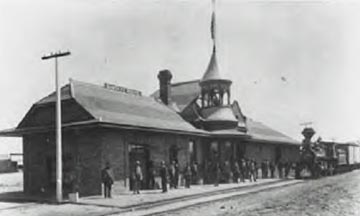 The Station
Agent was the man in charge of the railroad
station or depot. In smaller towns, this job also included being ticket agent, baggage handler and telegraph operator.
The Station
Agent was the man in charge of the railroad
station or depot. In smaller towns, this job also included being ticket agent, baggage handler and telegraph operator.
Following the introduction of the telegraph, the Telegraph Operator communicated the status of trains to the dispatcher, notifying the train crews of any problems or unexpected trains that may be ahead of them and communicated train orders issued by the dispatcher. They also would send warning messages to other depots up and down the line. Telegraphers at most small stations, in addition to their railroad duties, worked for Western Union, commissions supplemented wages from the railroad.
The Ticket Agent sold tickets and answered questions.
The Baggage Handler duties were to load and unload baggage from inbound and outbound trains. In small towns, the telegraph operator or station agent usually did this. In large towns, such as Omaha, it was a full time job, and like modern airports of today, the baggage handler had to make sure the baggage was placed on the right train, or was transferred from an inbound train to the right outbound train.
The Express Agent was employed by the express agency, and usually had an office in the depot. Their job was to ship packages, much like United Parcel Service (UPS) or Federal Express (Fed Ex) does today. Quite often, especially in smaller communities, the Express Agent was also on the payroll of the local railroad as the telegraph operator, or the ticket agent, or even the the station agent.
The Division Superintendent is individual with authority over a division, responsible for track maintenance and oversees scheduling and other duties contributing to smooth traffic flow between destinations. The Dispatcher schedules and monitors all train movement for all stations on a railroad line.
The Watch Inspector was typically a jeweler who had an established business in town. Accurate time was critical to railroad operations, by the mid-1890's Webb Ball's Time Service had contracts with the railroads and local jewelers to inspect watches. Watches were cleaned, inspected and calibrated on a regular basis to ensure that they all remained accurate. The conductors and engineers were issued small cards to record the watches performance, if a watch fell behind or gained more than 30 seconds in 7 to 14 days it had to be sent in for repair. Watches were typically inspected every six months, and cleaned by a jeweler every 18 months, loaner watches were provided by jewelers while a watch was in for cleaning or repair.
Yard Workers
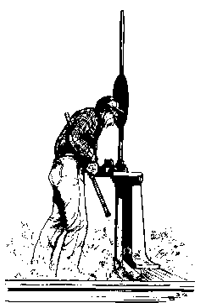 The Yardmaster was in charge of switching and yard
operations. The Yardmaster and his crew helped "make up" the freight trains in the yards so that
freight cars would be placed in trains going toward their destinations.
The Yardmaster was in charge of switching and yard
operations. The Yardmaster and his crew helped "make up" the freight trains in the yards so that
freight cars would be placed in trains going toward their destinations.
The Switchman worked in the railroad yards aligning the track switches and hooking cars together, sometimes while the cars were moving. Before automatic couplers were installed this was a dangerous position. During the early years the railroads used link and pin couplers which weren't always the same exact height and made the job very dangerous. Between 1877 and 1887, approximately 38% of all railworker accidents involved coupling. Automatic knuckle couplers, first patented by Eli H. Janney in 1873, helped make the job safer. The Safety Appliance Act in 1893 made air brakes and automatic couplers mandatory on all trains in the United States.
The Carman used long spouted cans for oiling the old style brass journal boxes, a task that was gradually eliminated by roller bearings. Carmen also filled engine and passenger car tanks with water.
The Wiper typically work a 12 hour shift in the roundhouse, where he packed the internal moving parts of some engineer's beloved engine with wads of greasy waste. This was the bottom rung on the latter that climbed to the engineer's seat.
The Switch-engine Engineer position was held by apprentice engineers learning the trade. Their job was to move railroad cars around the railroad yard to get freight cars together on the right track for the road engines to pickup just before leaving the station. Once the apprentice engineer proved his ability with handling the switch-engines, the next opening for a Road Engineer would be his.
The Hostler would go into the yard and pick up an engine from where the journeyman Engineer left it running, and move it into the roundhouse.
Track Workers
The Section Foreman is the person in charge of a group of track workers for a section of track. The Section Foreman was also responsible for daily inspection of the entire section. On the Atchison, Topeka & Santa Fe a section of track was typically six to eight miles long.
Section Crews, or Section Gangs as they were commonly known, were responsible for maintaining a several mile long section of track. They typically lived along the section of track they were responsible for and rode handcars to look for, and replace, rotted ties, tamp loose spikes, tighten bolts, reinforcing roadbeds and clearing weeds and debris.
A Gandy Dancer is a slang term for workers who maintained railroad tracks in North America. Over time the weight of trains over curves would cause the track to shift outward. Nineteenth and early twentieth century track crews used specialized hand tools known as gandies to align rail tracks into position. For each stroke, each worker would lift his gandy and force it into the ballast to create a fulcrum, then in unison with other workers use his full weight so the gandy would push the rail toward the inside of the curve.
With the introduction of electric block signals and railroad crossing signals in the twentieth century, the Signal Maintainer was responsible for maintaining signals and telegraph lines. As the twentieth century progressed this also included hot box detectors, dragging equipment detectors, railroading crossings, and CTC.
For Additional Reading:
- Ducker, James H. Men of the Steel Rails: Workers on the Atchison, Topeks & Santa Fe Railroad, 1869-1900. Lincoln, Nebraska, University of Nebraska Press, 1983.
- Hubbard, Freeman. Railroad Avenue: Great Stories and Legends of American Railroading. Revised edition, 1964, Golden West Books, San Marino, CA.
The following books contain oral histories from those who have worked for the railroads:
- Leuthner, Stuart. The Railroaders. New York, Random House, 1983.
- Perata, David D. Those Pullman Blues: An Oral History of the African American Railroad Attendant. New York, Twayne Publishers, 1996.
|
Union Pacific Past and Present Railroad Job Descriptions
The following list of past and present positions on the Union Pacific Railroad provides insight into the number of people it takes to run a mainline railroad (list courtesy of Union Pacific): Train Crew
Dispatching Center Personnel
Yard or Field Operations
Passenger Train Personnel
Survey and Construction Personnel
|
Sharing A Heritage Railroad History Train Technology Railroad Operation Railroad Time Museums & Heritage Railroads Railroads Today
